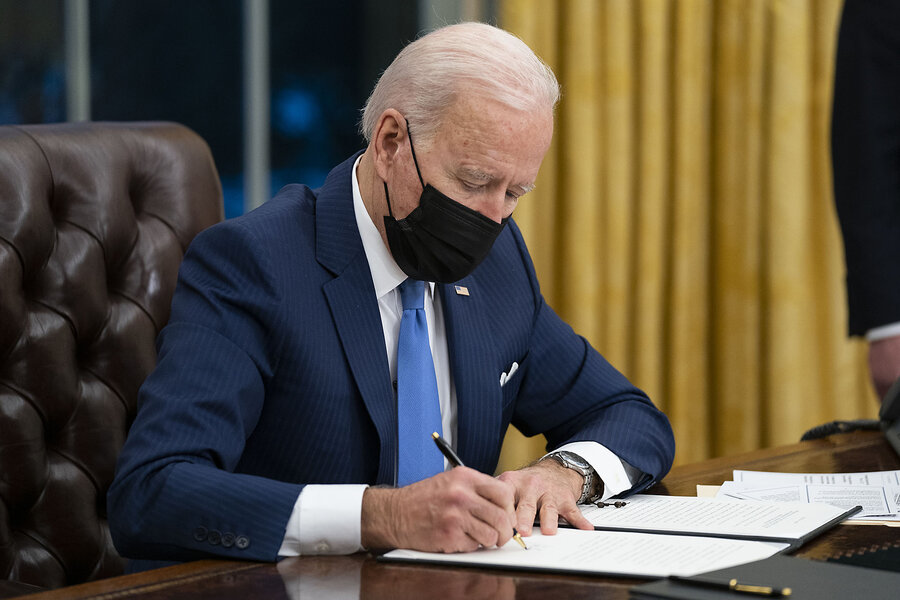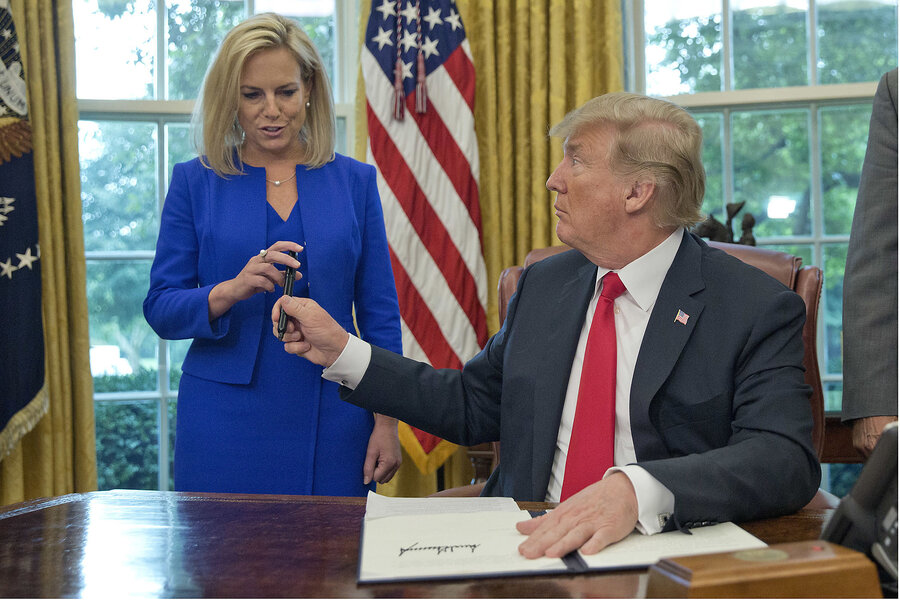What Biden can do to seal US border – and the role Congress plays
Loading...
| Washington
President Joe Biden and congressional Republicans agree there is a “crisis” at the southern border.
But they disagree on whether the president has the authority to make substantial policy changes alone – or must wait on Congress for more sweeping reforms and the funding to enact them.
Why We Wrote This
With a border security bill looking unlikely to pass, experts say the president can take some steps to stem a surge in crossings. But big policy changes – and funding for them – must come from lawmakers.
Mr. Biden has urged Congress to pass the bipartisan Senate deal released this weekend, saying it would give him new emergency authority to “shut down” the border – authority he has pledged to use immediately. His vow, in effect acknowledging a failure to adequately control a migrant surge under his watch but putting the onus on Congress to act, has sparked a broader debate about how much executive authority Mr. Biden already possesses to secure the border.
Now that question has taken on greater urgency. With the Senate deal looking increasingly unlikely to pass, executive authority may end up being Mr. Biden’s only option.
The debate goes to the balance of power between two of America’s three branches of government, and raises the question of who is ultimately accountable for securing the border. That’s not only a policy question but also a political one, with one recent poll showing that immigration is now voters’ No. 1 concern heading into the 2024 presidential election.
President Joe Biden and congressional Republicans agree there is a “crisis” at the southern border.
But they disagree on whether the president has the authority to make substantial policy changes alone – or must wait on Congress for more sweeping reforms and the funding to enact them.
Mr. Biden has urged Congress to pass the bipartisan Senate deal released this weekend, saying it would give him new emergency authority to “shut down” the border – authority he has pledged to use immediately. His vow, in effect acknowledging a failure to adequately control a migrant surge under his watch but putting the onus on Congress to act, has sparked a broader debate about how much executive authority Mr. Biden already possesses to secure the border.
Why We Wrote This
With a border security bill looking unlikely to pass, experts say the president can take some steps to stem a surge in crossings. But big policy changes – and funding for them – must come from lawmakers.
Now that question has taken on greater urgency. With the Senate deal looking increasingly unlikely to pass, executive authority may end up being Mr. Biden’s only option.
The debate goes to the balance of power between two of America’s three branches of government, and raises the question of who is ultimately accountable for securing the border. That’s not only a policy question but also a political one, with one recent poll showing that immigration is now voters’ No. 1 concern heading into the 2024 presidential election.
Mr. Biden’s likely rival, former President Donald Trump, issued 472 executive orders on border and immigration policies according to a 2022 report from the Migration Policy Institute, which supporters credit with keeping illegal crossings to an average of half a million per year. Among other things, the Trump administration required 70,000 migrants to await far-off court dates outside the United States through his “Remain in Mexico” initiative, revived a Clinton-era provision that fined unauthorized immigrants up to $813 per day if they didn’t comply with an order to leave the country, and – once the pandemic hit – invoked a 1944 law to expel migrants on public health grounds.
Mr. Biden, who campaigned on promises of instituting a more humane and comprehensive approach to fixing America’s broken immigration system, reversed many of those policies through executive action that at least initially outpaced Mr. Trump. On his first day in office, Mr. Biden terminated the national emergency at the southern border, and with it the construction of a border wall – and sent Congress a comprehensive immigration reform bill that the Migration Policy Institute characterized as the most ambitious in a generation.
But in the three years since, Congress has so far failed to pass such legislation. Meanwhile, the average number of annual crossings has quadrupled to more than 2 million, though that number reflects in part a higher rate of repeat attempts by migrants expelled on public health grounds. This fall the Biden administration announced plans to restart construction on a portion of Mr. Trump’s border wall, and the president asked Congress for $13.6 billion to address the crisis.
Republicans say if Mr. Biden would just avail himself of the powers already at his disposal, the bulk of the illegal crossings could be stopped virtually overnight. In a rebuke of what they call irresponsible Biden administration policies, GOP House members were expected to hold a vote today on impeaching Homeland Security Secretary Alejandro Mayorkas. Speaker Mike Johnson has compiled a list of 64 executive actions the Biden administration has taken that Republicans say undermined border security and encouraged illegal immigration.
“Without any congressional action, Biden could fix this crisis,” says Mark Morgan, who served as acting commissioner of U.S. Customs and Border Protection in the latter part of the Trump administration. “With that same pen that he used to stop [Mr. Trump’s] policies, he could reinstitute them.”
But while Mr. Trump’s policies were depicted by supporters and critics alike as some of the most restrictive in history, they did not shut down the border. Though illegal crossings dropped significantly as the president set a tough tone in his first year in office, they increased substantially later in his tenure before he implemented additional policies. Those included expedited deportations and a deal with Guatemala to limit asylum-seekers in July 2019, after which the numbers dropped precipitously.
At the same time, courts overturned some of Mr. Trump’s policies. And there were still significant gaps: The wall he promised to build was not completed, the border remained porous, and immigration courts were backlogged. Democrats say Mr. Trump’s actions were not nearly as effective as he and his allies claimed, and add that the policies presented a threat of a different kind to America.
America will survive as a nation only if “we live up to our basic values of fairness and justice and treating people well,” says Democratic Sen. Chris Murphy, calling Remain in Mexico a “deeply inhumane” policy. Rights groups say migrants were subject to kidnapping, assault, and other dangers while awaiting word in Mexico.
Many immigration experts say a president can steer policy to some extent, but that numerous other factors affect border security – from global migration trends to job prospects in the U.S. to Congress’ willingness to allocate funding for things like border agents and immigration judges. Both sides agree that the asylum system is broken and needs an overhaul.
“Because of existing law, whether [asylum-seekers] make that claim at a legal port of entry or are just caught crossing the Rio Grande illegally, once they do, the border agents are required to begin their processing,” says Gary Schmitt of the American Enterprise Institute by email. “So, while there are various things the president might try and do with executive orders, the biggest thing that needs addressing is only something the Congress can fix.”
Indeed, Mr. Trump and his GOP allies repeatedly urged congressional action during his tenure. And as recently as December 2023, GOP Speaker Johnson called for statutory reforms to be enacted, though he also called on Mr. Biden to use a 1965 provision known as 212(f) that allows the president to restrict or suspend the entry of migrants he deems “detrimental to the interests of the United States.”
While both parties have increasingly sought to accomplish their policy goals through executive action, experts across the spectrum say that only Congress can and should enact more sweeping changes on an issue this complex and important – unless voters want a monarch instead of a president.
The Senate deal, brokered by a Democrat, an independent, and a Republican, would give the president the authority to shut down the border when the daily average of illegal crossings over a seven-day period reaches 4,000. It would require him to do so when that figure reaches 5,000. In the past several months, the U.S. has hit that average all but one week, according to the GOP negotiator, Sen. James Lankford. It also raises the threshold for asylum-seekers and adds penalties for deportees who try to cross again.
Both hard-line Republicans who say the deal would normalize thousands of illegal crossings a day, and progressive Democrats seeking more comprehensive reforms, have taken issue with talk about “shutting down” the border.
“Is there a door that rolls down?” asks New York Rep. Alexandria Ocasio-Cortez, saying the lack of specificity suggests the rhetoric is more political than practical.
“It becomes more of a slogan” than actionable policy, says lawyer Muzaffar Chishti, a senior fellow with the Migration Policy Institute. “Let’s say [Mr. Biden] says, ‘I’m going to expel everyone.’ You can’t expel people to Mexico unless Mexico accepts them.”
Indeed, though Speaker Johnson has called for renegotiating Remain in Mexico, Mexico now opposes the policy. Meanwhile, Mr. Trump has urged House Republicans not to compromise on border security – a stance consistent with his record but one that would also likely benefit him politically in this year’s presidential election. Even if the border deal were to somehow pass the Senate, Speaker Johnson has declared it “dead on arrival” in the House.
“Illegal immigration is illegal; it is against the law. Why would you tolerate 5,000 a day before you sought to suddenly enforce the law?” asked Mr. Johnson, a constitutional lawyer, last week. “The goal should be zero, not 5,000 – and all the president’s authority should be utilized at zero.”









